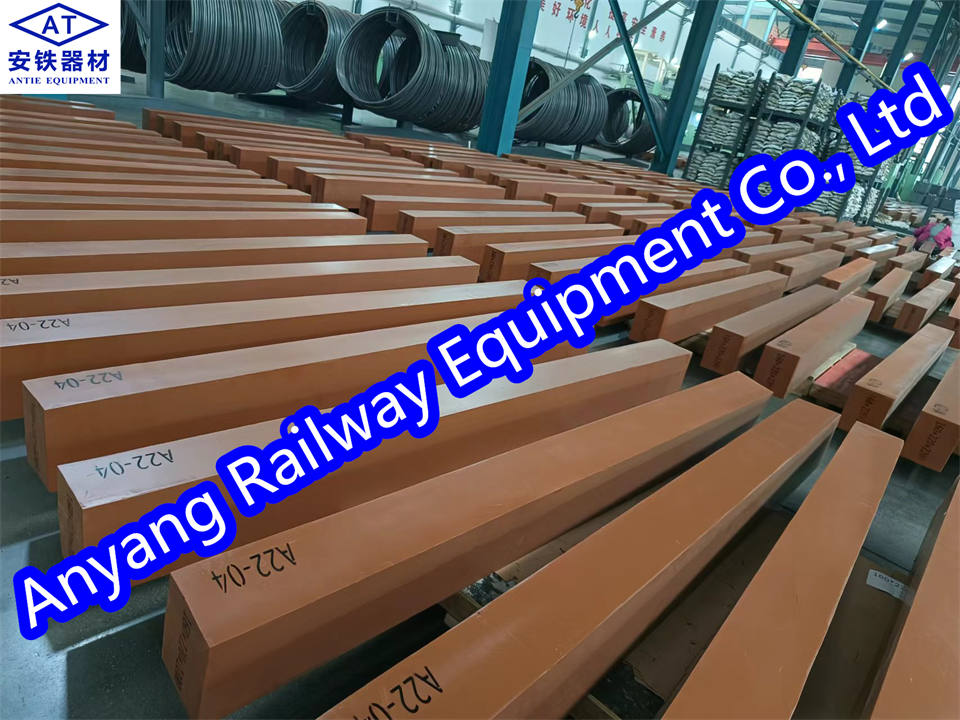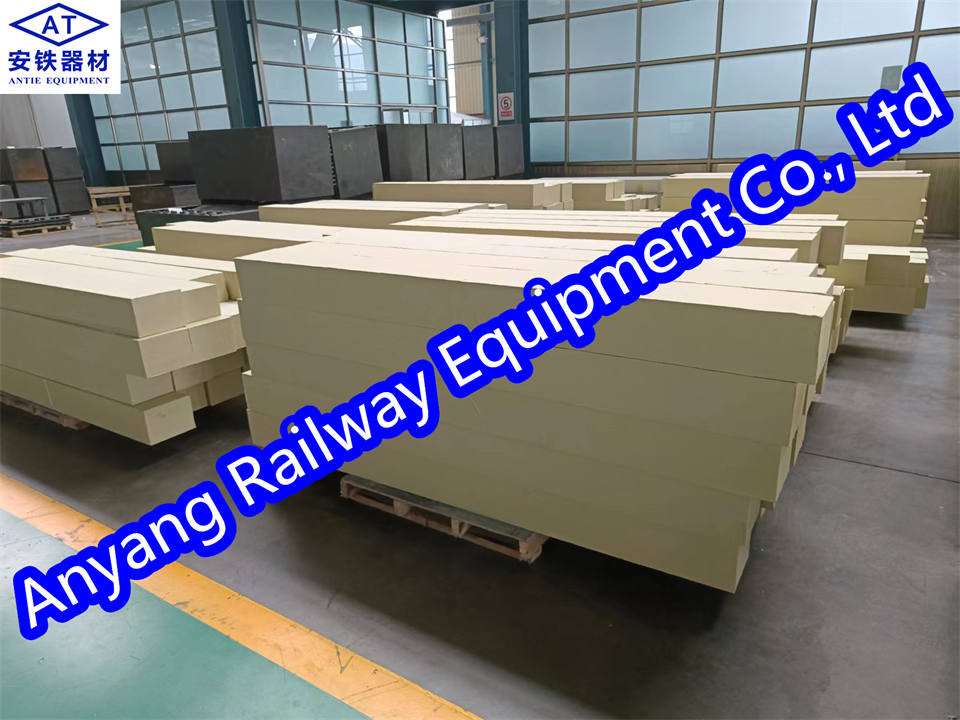Application of glass fiber reinforced polyurethane sleepers (Synthetic Sleepers/Composite Sleepers) in the field of rail transit
Mar 15, 2024
Just as cars have entered the new energy era, rail transit is starting a new life cycle along the same path as the automobile manufacturing industry - the new development trends of high speed, safety, lightweight and environmental protection.
In response to these development trends, increasing train speeds and heavy axle loads have increased the vibration intensity of locomotives on the track, and accordingly the risk of damage to track geometry and structural components has increased. The hardening of the track bed of ballastless tracks and the rapid pulverization of ballast shorten the service life of the track and increase maintenance efforts. However, traditional wooden sleepers are easy to corrode and break, have a short service life, and are difficult to maintain. Concrete sleepers are heavy, difficult to construct, and vibrate greatly when trains pass by, making them unsuitable for long-span bridges.
On the other hand, railway vehicles produce rolling noise and vibration during operation. This is caused by the roughness and imbalance of the running surfaces of the wheels and rails. It is well known that surface defects on rails such as heads, corrugations and slip waves are the most common sources of disturbances. When transmitted through the air and building structures, it seriously endangers human health, especially in cities and surrounding towns. Therefore, it is very necessary to adopt sound insulation and noise reduction projects.
In response to these development trends, increasing train speeds and heavy axle loads have increased the vibration intensity of locomotives on the track, and accordingly the risk of damage to track geometry and structural components has increased. The hardening of the track bed of ballastless tracks and the rapid pulverization of ballast shorten the service life of the track and increase maintenance efforts. However, traditional wooden sleepers are easy to corrode and break, have a short service life, and are difficult to maintain. Concrete sleepers are heavy, difficult to construct, and vibrate greatly when trains pass by, making them unsuitable for long-span bridges.
On the other hand, railway vehicles produce rolling noise and vibration during operation. This is caused by the roughness and imbalance of the running surfaces of the wheels and rails. It is well known that surface defects on rails such as heads, corrugations and slip waves are the most common sources of disturbances. When transmitted through the air and building structures, it seriously endangers human health, especially in cities and surrounding towns. Therefore, it is very necessary to adopt sound insulation and noise reduction projects.
.png)
According to different material properties, sleepers can be divided into wooden sleepers, reinforced concrete sleepers, steel sleepers and polyurethane sleepers. In recent years, with the increasing requirements for train speed and the in-depth research on polymer materials, glass fiber reinforced polyurethane microporous elasticity Body sleepers have become a new development trend in the sleeper industry.
Glass fiber reinforced polyurethane foam
Existing cases at home and abroad have verified that one way to improve track life and increase maintenance intervals is to reduce the differential settlement between the two track structures at the track transition. Polyurethane elastic cushions are used to reinforce the ballast, which is to reduce the interaction between wheel and rail. It is an effective practical way to slow down ballast pulverization and reduce track maintenance. Also in order to reduce railway noise, railway dampers are recognized by railway networks globally as a means of complying with noise legislation and environmental planning regulations. Polyurethane rigid foam elastomeric underlays are excellent track dampers designed to reduce the noise generated by rolling stock and are easily installed onto existing and new track systems so:
- The settlement of rigid polyurethane foam reinforced ballast is reduced by 60% compared to traditional unreinforced ballast, and the settlement of the semi-reinforced layer is reduced by 42%;
- Polyurethane shock-absorbing material has obvious noise reduction effect in the range of 100~400 Hz
- Excellent ability to maintain its elasticity and geometry over a design life of over 30-50 years.
Compared with wooden sleepers, reinforced concrete sleepers, etc., polyurethane foam synthetic sleepers have significant new-era characteristics of shock and noise reduction, durability, low carbon and environmental protection, and high cost performance. Taken together, their important effects on the railway system are:
- Promote lightweighting.
- Excellent mechanical properties, bending strength and shear strength.
- Low water absorption, high weather resistance, chemical corrosion resistance.
- Good insulation, high insulation resistance, no need to install insulating pads.
- Shock absorption and noise reduction, reducing secondary airborne sound.
- Maintain track position stability and extend product life.
- Improve driving comfort, rail safety, and protect the track bed.
- Reduce maintenance costs and workload on rail infrastructure.
- Can perform secondary processing such as slotting and drilling.
- Recyclable, no pollution to the environment.
- Improve safety across the rail system.
| Item | Synthetic Sleeper | Concrete Sleeper | Wooden Sleeper | |||
| Strength | High strength, good flexibility, reduce vibration and noise |
○ | Reinforced concrete sleepers have very high strength but poor flexibility. | ○ | The strength is uneven and decreases in strength over the years. | △ |
| Durability | It is not easy to corrode and has strong water resistance, and is stable for many years. | ○ | Although durable, steel bars are prone to corrosion and have a short lifespan. | ○ | It has poor corrosion resistance and is prone to cracks when dry. Its service life is 10-15 years. | × |
| Constructability | Light weight, easy to construct, can be processed on site, short construction period | ○ | It is heavy, difficult to construct, cannot be processed on site, and has a long construction period. | △ | Light weight, convenient for transportation and construction, short construction period | ○ |
| Repair and renovate | Spike holes are easy to repair and can flexibly respond to changes in track position. | ○ | It is difficult to repair spike holes, and it is difficult to adjust the track position. | × | It is difficult to repair and refurbish spike holes, and they can generally only be used once. | × |
| Productivity | Continuous mold method, stable efficiency, high quality and short delivery time. | ○ | The fixed-length mold method has low efficiency, large number of molds, and long delivery time. | △ | Long-dimension lumber is difficult to purchase and has long lead times | △ |
| Environmental protection | It can be reused after repair and renovation, or it can be recycled and reused. | ○ | Although it can be used for roadbed gravel, it is difficult to resource it. | △ | In order to protect forest resources, wooden sleepers are gradually no longer used. | × |
| Economy | Long life and easy construction, etc. Can reduce total cost | ○ | The weight is heavy and the construction cost increases. The cost of small batch production is high. | △ | The product life is short, which increases the number of replacements and maintenance and management costs. | △ |
| Overview | It is a high-performance new material suitable for railway sleepers. | ○ | The heavy weight makes transportation and construction more difficult and expensive. | It has a short service life, consumes forest resources, and is rarely used for sleepers. | × |
|

Growing promotion
By the end of 2021, China's high-speed railway operations have exceeded 40,000 km. With the rapid development of the rail transit market and increasingly stringent environmental protection supervision, the high-speed rail and urban rail transit industries have become faster, safer, and lighter. Polyurethane sleepers replacing wooden sleepers and reinforced concrete sleepers may become a new development direction for the sleeper industry in the future.

Applied to urban rail transit
In response to the problems that the sleepers (concrete and wooden sleepers) used by China's railways in the past were prone to cracking, short life, and difficult to maintain, some domestic material manufacturers deeply involved in the polyurethane sector have developed synthetic resin sleepers made of glass fiber reinforced foamed polyurethane. It takes into account all the advantages of concrete and wooden sleepers, and at the same time strengthens its own advantages: light weight, about 80% lighter than concrete sleepers; high strength, good track gauge maintenance; acid and alkali resistance, salt spray resistance, ultraviolet resistance, and damp heat resistance Good aging performance; insulation, flame retardant, insect-proof; low overall life cycle cost, etc. At present, it has been well promoted in Beijing, Shanghai, Guangzhou, Shenzhen and cities where important rail transit is running on a large scale.
Applied to bridge sleepers
Currently, polyurethane composite bridge sleepers serve highway and railway bridge sections in many places across the country. Composite bridge sleepers made of glass fiber reinforced foamed polyurethane are used. The support system evenly distributes the physical forces and vibrations generated when the train travels on a section of track, ensuring the safety of the train and playing a good role in reducing shock and noise. This new type of bridge sleeper has a service life of up to 50 years, which is nearly three times longer than the 15-20 years of traditional railway sleepers.
When building railways and highways in permafrost and seasonally frozen soil areas, corresponding anti-freeze measures must be taken to avoid frost heaving or melting damage to road genes, causing huge losses. Polyurethane synthetic materials for frozen soil roadbed have become national standards and are widely used in highway and railway roadbeds in frozen soil areas, especially in high-cold and high-altitude areas such as the Qinghai-Tibet Line, Yunnan-Tibet Line, and Sichuan-Tibet Line. In cities and villages in high-altitude areas, continuous glass fiber reinforced polyurethane synthetic sleeper rails have strong weather resistance, fracture resistance and year-round high cold. They serve as a vibration-sensitive sealing layer to protect the sensitive sealing layer from damage by ballast stones and meet the requirements of uniform roadbed engineering in frozen soil areas. It has consistent technical requirements and can withstand strong ultraviolet radiation in plateau areas, as well as the impregnation of regional soil and oils exposed during construction.
Next :

